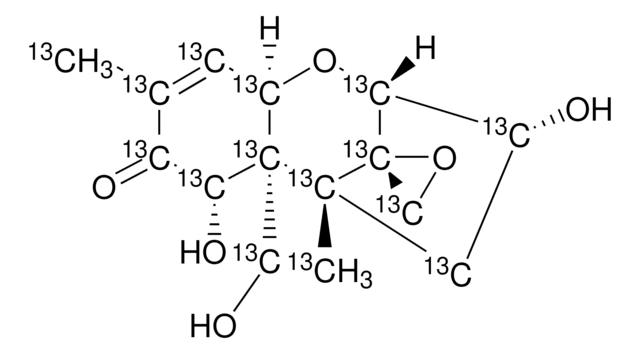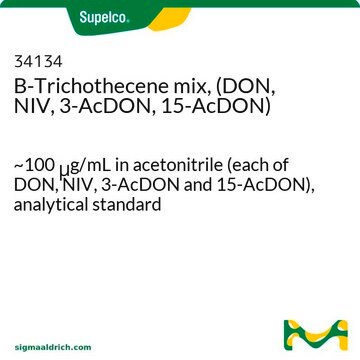34124
Deoxynivalenol solution
100 μg/mL in acetonitrile, analytical standard
Sinônimo(s):
3α,7α,15-Trihydroxy-12,13-epoxytrichothec-9-en-8-one, DON, Vomitoxin
About This Item
Produtos recomendados
grau
analytical standard
prazo de validade
limited shelf life, expiry date on the label
concentração
100 μg/mL in acetonitrile
técnica(s)
HPLC: suitable
gas chromatography (GC): suitable
aplicação(ões)
cleaning products
cosmetics
food and beverages
personal care
formato
single component solution
temperatura de armazenamento
−20°C
cadeia de caracteres SMILES
CC1=C[C@H]2O[C@@H]3[C@H](O)C[C@@](C)([C@]34CO4)[C@@]2(CO)[C@H](O)C1=O
InChI
1S/C15H20O6/c1-7-3-9-14(5-16,11(19)10(7)18)13(2)4-8(17)12(21-9)15(13)6-20-15/h3,8-9,11-12,16-17,19H,4-6H2,1-2H3/t8-,9-,11-,12-,13-,14-,15+/m1/s1
chave InChI
LINOMUASTDIRTM-QGRHZQQGSA-N
Procurando produtos similares? Visita Guia de comparação de produtos
Categorias relacionadas
Descrição geral
Check out our entire range of trichothecene type mycotoxin reference materials
Aplicação
Palavra indicadora
Danger
Frases de perigo
Declarações de precaução
Classificações de perigo
Acute Tox. 4 Dermal - Acute Tox. 4 Inhalation - Acute Tox. 4 Oral - Eye Irrit. 2 - Flam. Liq. 2
Código de classe de armazenamento
3 - Flammable liquids
Classe de risco de água (WGK)
WGK 2
Ponto de fulgor (°F)
35.6 °F - closed cup
Ponto de fulgor (°C)
2 °C - closed cup
Equipamento de proteção individual
Eyeshields, Faceshields, Gloves, type ABEK (EN14387) respirator filter
Choose from one of the most recent versions:
Já possui este produto?
Encontre a documentação dos produtos que você adquiriu recentemente na biblioteca de documentos.
Os clientes também visualizaram
Conteúdo relacionado
Detailed list of mycotoxin analysis products for Food & Beverage manufacturers and testers, ensuring safety standards.
Nossa equipe de cientistas tem experiência em todas as áreas de pesquisa, incluindo Life Sciences, ciência de materiais, síntese química, cromatografia, química analítica e muitas outras.
Entre em contato com a assistência técnica









